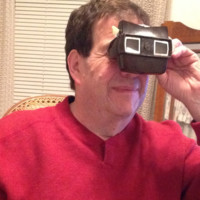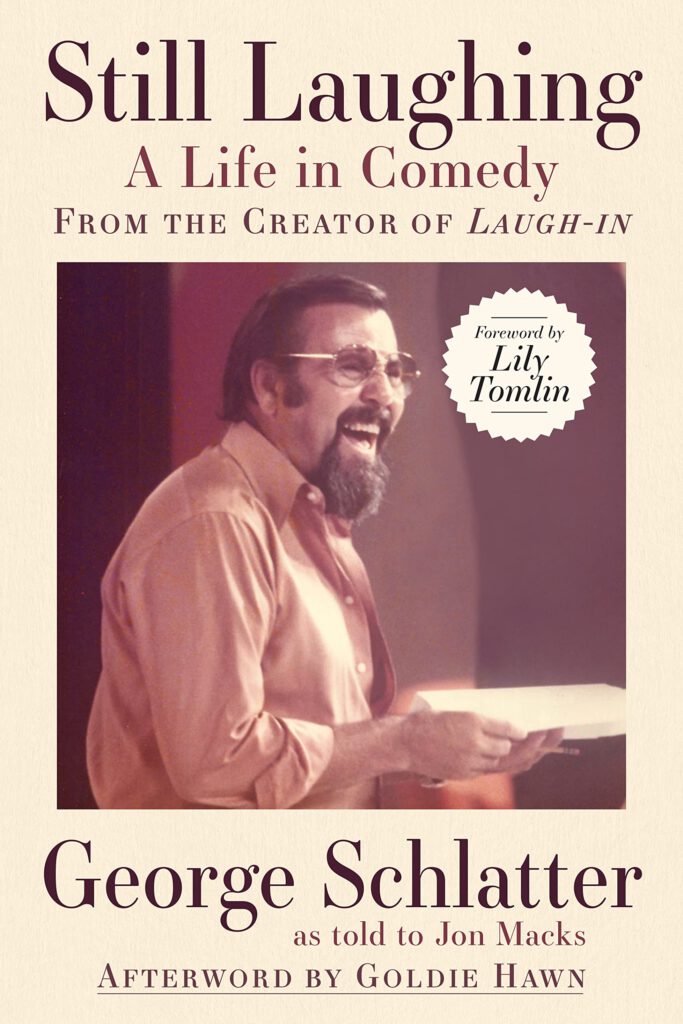If you moved in the same elite comedy and show business circles as George Schlatter, chances are you’d run into him at a party, where you could corner him for stories from his more than 60-year career. I, for one, do not, so the next best thing was to read his new memoir, Still Laughing: A Life in Comedy.
When I mention this to Mr. Schlatter, he doesn’t miss a beat. “The book is better,” he jokes. “The book you could walk away from.”
But you won’t want to. Schlatter has worked with a who’s-who from A (Paula Abdul) to Z (Pia Zadora). If you love vintage show business stories like I know I do, Still Laughing is brimming with such priceless tales as how he created the Las Vegas lounge act, his friendship with Frank Sinatra, and the creation of two shows that changed television, the pell-mell-paced “Rowan & Martin’s Laugh-In,” the era-defining comedy hour that launched the careers of Goldie Hawn and Lily Tomlin (who penned the book’s foreword), and “Real People,” which mainstreamed reality television.
This is Show Business with a capital S, capital B (with a little BS thrown in for good measure).
Schlatter, 93, spoke with RogerEbert.com about “Laugh-In’s” unexpected success, his eye for talent (he cast a pre-Mork Robin Williams), and why he considers “Turn-On,” a show that was actually canceled before the pilot episode finished airing, to be the proudest moment of his career.
Your life in comedy began in the early 1930s. That means you got to see movies starring The Marx Brothers, W.C. Fields, Abbott & Costello, Bob Hope, and Laurel & Hardy in their theatrical runs.
It was a turn-on. We have to laugh, and that’s what got me through a lot of things.
What about radio? Who were your favorite comedians?
Bob Hope, of course. Milton Berle and Danny Thomas were my early, early introduction to comedy.
Not Jack Benny?
Oh, yes, Jack Benny. We had great fun with Jack Benny on “Laugh-In.” It was a learning curve for him. His pacing is so deliberate, and the show was so fast. But he loved doing the show, and he loved Goldie Hawn.
Here’s how large “Laugh-In” loomed in our house. My parents used it as leverage. If I did my homework, I could watch it. If I didn’t, I couldn’t, and not watching “Laugh-In” was not an option. Everyone talked about it at school the next day.
As with many things in my career, “Laugh-In” was an accident. I had done “The Dinah Shore Chevy Show” and Judy Garland’s variety series. NBC came to me and said they got no ratings at all on Monday nights at 8 p.m. because they were opposite “Gunsmoke” and “Here’s Lucy.” They asked if I had anything to put in there. I collected young and attractive character people like Ruth Buzzi, Judy Carne, Henry Gibson, Larry Hovis, Artie Johnson, Jo Anne Worley, and later Hawn and Tomlin. NBC said they didn’t know any of them, and I said that was the point.
NBC had never seen anything like the pilot. They said it was too fast and that no one would understand it. We ran it for some kids, and they understood it. NBC reluctantly put it on because they had nothing else. And by the third week, it exploded [It was rated No. 1 in two of its six seasons and won six Emmys].
There is a new coffee table book coming out this month, Ernie in Kovacsland. Ernie Kovacs is cited as a major influence on “Laugh-In.”
Ernie Kovacs was a lot of my inspiration. We were at a party when he met my wife, Jolene Brand [they’ve been married 67 years]. He absolutely adored her and hired her to be a straight woman on his show [she was the piano-playing member of the iconic Nairobi Trio and The Woman in the Bathtub in the show’s blackouts]. Ernie and I used to argue constantly about my obsession with punchlines. He wanted to be vaguer, or whatever. One night he called me and said he wanted me to come over to the studio. He was there with a raised stage and a car. He put his hand on the car and it went right through the floor. He said, “Now, that’s a punchline.”
You write that Dan Rowan and Dick Martin did not get along. How did that work?
They got along well enough to have a top-rated show. They were totally different. Dan was very straight, and Dick was a playboy. Dan was one of the greatest straight men ever. Why it worked, I never figured out, but it worked.
“Laugh-In’s” ensemble was lightning in a bottle, comparable to “Saturday Night Live’s” original cast.
Lorne Michaels was one of our writers. The people who auditioned for “Laugh-In” didn’t audition for the network. It was people I saw. Goldie was a dancer. I was absolutely enchanted by her, so I put her on the show. Once, she introduced Dan Rowan, and she blew the introduction. The director interrupted her and said to do it again, and I said, “Don’t ever interrupt this woman.” When she read the wrong words, she would laugh. And that laugh … her laughter paid my mortgage.”
Perhaps the show’s most iconic moment was when presidential candidate Richard Nixon said the show’s signature catchphrase, “Sock it to me.” How did you pull that off?
It just happened: We needed something to open the second season. And [Laugh-In] writer Paul Keyes was a close friend of Mr. Nixon. He said he could get him. Nobody ever thought Nixon had a sense of humor. That show got so much press. (Pause) He was not a funny person.
You have a keen eye for talent. When “Laugh-In” was revived in the 1970s, you cast a pre-Mork Robin Williams. How did you find him?
Robin Williams was another adventure for me. I saw him on the streets of San Francisco. I fell in love with this guy. He was so bright and so funny. Everybody, when they met Robin, they were intimidated.
Lenny Bruce said that comedy is tragedy plus time. Which brings us to the ill-fated “Turn-On,” one of the great stories in your book. The promo for the series is on YouTube. What a night that was for ABC: an episode of “Here Come the Brides,” the premiere of “Turn-On” and the movie “Spartacus.” But the show was canceled before it had even completed airing!
At that point, I was really hot. ABC was willing to try anything. I had this idea for this out-of-the-box improvisational comedy show. We’d call it “Turn-On.” We delivered the first show. ABC committed to 13 shows which, amazingly, they expanded to 16 shows. We put it on the air with enormous fanfare and promotion. A [station] guy in Cleveland wanted to keep “Peyton Place” on the air. He started calling stations. Starting in New York, stations started canceling it, and by the time it aired in Los Angeles, it had been canceled. But the show was magnificent. It was my proudest moment.
It’s been said, “Don’t meet your heroes.” You’ve worked and been friends with many show business legends. Who impressed you as being just like you hoped they would be?
We had a lot of fun with Peter Sellers [on “Laugh-In”]. We had an hour and a half with him. He played eight characters. Orson Welles was a surprise. He loved comedy. The fact that we gave a window to dramatic actors was one of the reasons for our success. If we could get Orson Welles, others were willing to be on the show. We got people like William F. Buckley. It was a big playpen. I wish we could get back to that. We really need it.
Let’s plug one of your latest projects, the George Schlatter and Jolene Brand Schlatter Theatre, to be inaugurated at the National Comedy Center in Jamestown, NY.
I’m enormously excited about that. They asked if I had clips from “Laugh-In.” I said that I have a warehouse full of material. I fell in love with the project. The National Comedy Center is the only place that celebrates comedy and comedians. Those people who make us laugh are to be treasured.
Get a copy of “Still Laughing: A Life in Comedy from the Creator of Laugh-In” here.












